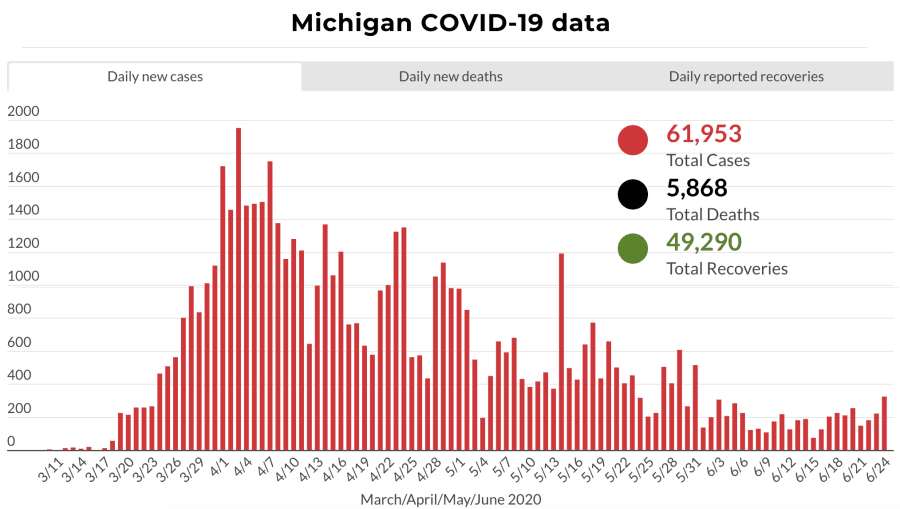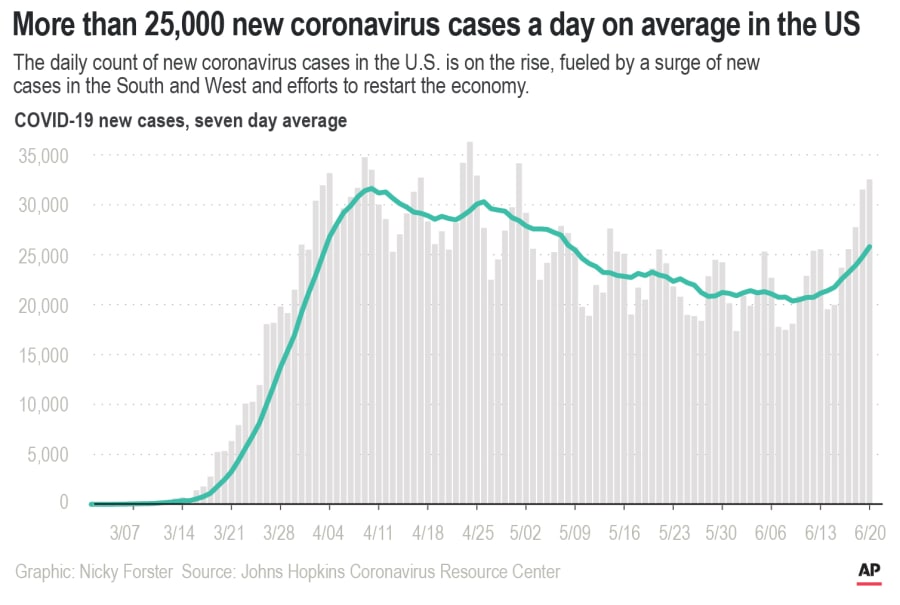This article first appeared in the Morning Report Newsletter. Sign up to get it to your inbox here.
Recommended Videos
On Wednesday, Michigan reported 323 new COVID-19 cases -- the highest one-day total since May, and the first day of more than 300 new cases since June 3. These aren’t astronomically higher numbers than where we’ve been at -- near 200 -- but the trend has increased.
The rolling 7-day average of cases is up slightly, and the last few days have showed a slight bump in new cases. Here’s a look at the daily case chart:

So, cases are increasing a bit. But the biggest indicator for us are hospitalizations. Since last Friday, inpatients statewide, including critical care and ventilator use, have increased, slightly. Data for the last three days shows an uptick in all categories.
It’s the first increase we’ve seen in hospitalizations since tracking, dating back to April 12. So, that’s concerning. (You can see hospital data here).
Deaths have slowed to below about 10 new deaths per day for the last several days, so that’s a good thing. In states seeing big surges in virus cases, young people are the demographic with the most growth.
Well, isn’t testing up?
Testing, testing, testing. You’ve heard a lot about testing. In Michigan, testing sort of peaked a few weeks ago, with about 15,000 per day, but that has actually come down a bit, now closer to, or below 14,000 on most days.
So, it’s hard to point to testing as the reason why we’re seeing an increase in cases -- because testing has not increased, especially not in the last two weeks. Michigan has improved its testing since April, improving from 25th to 12th in testing. But at this point, it’s flat.

President Donald Trump said Monday the United States has done “too good a job” on testing for cases of COVID-19, even as his staff insisted the president was only joking when he said over the weekend that he had instructed aides to “slow the testing down, please.” But the U.S. is actually 26th in testing rate in the world (per 1 million).
Is this the second wave?
So, the thing about waves is that we probably won’t know how many waves we’ve had until this is all over and we look back at the data.
But judging from the data we have now, the U.S. is definitely still in the first wave of cases. Michigan is included in this, although Michigan’s first wave declined faster than in other states. It’s only June.
After trending downward for six weeks, the U.S. caseload has been growing again for over a week, particularly in the South and West. Some 34,700 new cases were reported nationwide Tuesday, according to the count kept by Johns Hopkins University. The number was higher than any other day except April 9 and the record-setting date of April 24, when 36,400 cases were logged.

While new cases have been declining steadily in early U.S. hot spots such as New York and New Jersey, several other states set single-day case records Tuesday, including Arizona, California, Mississippi, Nevada and Texas. Some of them also broke hospitalization records, as did North Carolina and South Carolina.
Cases are also surging in some other parts of the world. India reported a record daily increase of nearly 16,000 new cases. Mexico, where testing rates have been low, also set a record with more than 6,200 new cases.
Bottom line:
The pandemic is not over. Cases are surging in some U.S. states and across the world.
Here in Michigan, we’re seeing some warning signs of a potential coming surge in cases. But it’s nothing to push a giant red panic button on just yet. We’re going to continue tracking the key data points closely.
This was also not unexpected. Reopening businesses, lifting stay-home measures and allowing small gatherings are all higher risks than sitting at home.
COVID-19 cases aren’t going away any time soon, but if they get out of hand and hospitals become overrun with patients, states could decide to move back into restrictions. So, remember, there are things you can do to mitigate the chances of worsening the outbreak:
- Wear a mask when in public places like grocery stores, or near groups of people in any setting.
- Practice frequent hand washing and sanitization practices.
- Get tested for COVID-19. You can find a free testing site here.
- Avoid large gatherings, extended exposure to the public, and limit contact with anyone outside your household.
You already know these things, but it’s worth reminding ourselves. We’ll keep you posted with the latest data as we continue down the pandemic road. Stay safe out there. Let me know if you have a question.
This article first appeared in the Morning Report Newsletter. Sign up to get it to your inbox here.


